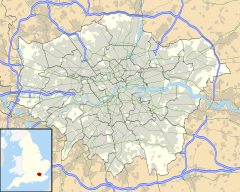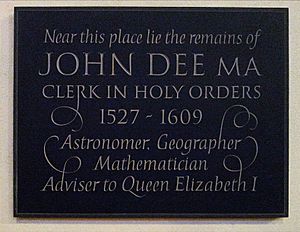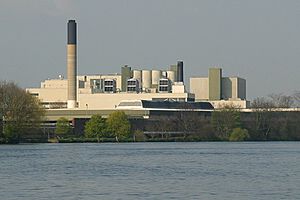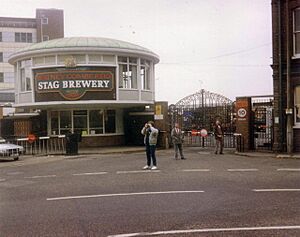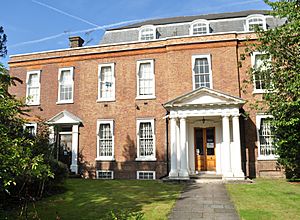Mortlake facts for kids
Quick facts for kids Mortlake |
|
|---|---|
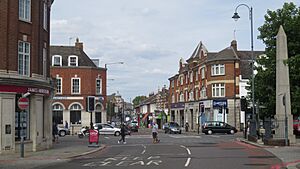 Mortlake from the Junction of Upper Richmond Road and Sheen Lane |
|
| Area | 4.50 km2 (1.74 sq mi) |
| Population | 10,919 (Mortlake and Barnes Common ward 2011) |
| • Density | 2,426/km2 (6,280/sq mi) |
| OS grid reference | TQ205755 |
| London borough | |
| Ceremonial county | Greater London |
| Region | |
| Country | England |
| Sovereign state | United Kingdom |
| Post town | LONDON |
| Postcode district | SW14 |
| Dialling code | 020 |
| Police | Metropolitan |
| Fire | London |
| Ambulance | London |
| EU Parliament | London |
| UK Parliament |
|
| London Assembly |
|
Mortlake is a part of London located on the south bank of the River Thames. It sits between the areas of Kew and Barnes. Long ago, Mortlake was a village and part of Surrey county. It even included areas like East Sheen and part of Richmond Park.
For many centuries, Mortlake was known for making malt (used in brewing), brewing beer, and farming. It also had skilled watermen who worked on the river. From 1617 to 1704, the Mortlake Tapestry Works was here. This was Britain's most important place for making beautiful woven pictures called tapestries. A famous building, the former Mortlake Brewery (also called Stag Brewery), is still a landmark in the area.
The Waterloo to Reading railway line runs through Mortlake. The area has a nice riverside path for walking, two riverside pubs (places to eat and drink), and a village green (a grassy public space). Every spring, the famous The Boat Race between Oxford and Cambridge universities finishes here.
Contents
What is Mortlake's Government Like?
Mortlake is part of the Mortlake and Barnes Common area within the London Borough of Richmond upon Thames. This area is called a 'ward'. In local elections, people vote for representatives to speak for them. In 2018, two members from the Conservative Party and one from the Liberal Democrats were chosen. In 2022, two Liberal Democrats and one member from the Green Party were elected.
This ward is also part of a larger area called the Richmond Park parliamentary constituency. This is the area that elects a Member of Parliament (MP) to the UK Parliament. Mortlake is also in the South West area for the London Assembly, which helps govern all of London.
What is Mortlake's History?
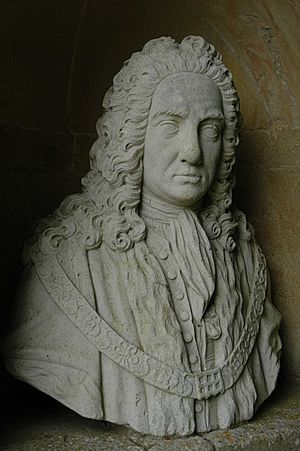
The name 'Mortlake' was first written down in a very old book called the Domesday Book in 1086. It was spelled Mortelaga or Mortelage. The name might mean 'salmon stream' or 'Morta's meadow'.
Mortlake was once part of a larger area called the hundred of Brixton. A 'hundred' was an old way to divide land in England.
The Domesday Book also says that the land and church of Mortlake belonged to Archbishop Lanfranc of Canterbury. It had many valuable things like mills, a place for fishing, and lots of farmland. It brought in a lot of money each year. The Archbishops of Canterbury owned Mortlake until the time of King Henry VIII. Then, it became property of the Crown (the King or Queen).
From the early 1600s, Mortlake became famous for making tapestries. This business, called the Mortlake Tapestry Works, started during the time of King James I.
In 1637, King Charles I created Richmond Park. This meant that Mortlake lost about 732 acres of its land to the new deer park.
A house called Colston House was once built by Thomas Cromwell, Earl of Essex. Later, it was owned by Edward Colston, a rich merchant from Bristol. This house was taken down in 1860.
John Barber, who was the Lord Mayor of London in 1733, is buried in Mortlake. He gave land to make the churchyard bigger. Sir Henry Taylor, a famous writer, lived in Mortlake in the 1800s.
Sir John Barnard was another Lord Mayor of London in 1737. He was also a Member of Parliament. He helped the government against a group called the Jacobites in 1745.
Since 1845, the Oxford and Cambridge Boat Race has ended in Mortlake. The finish line is marked by the University Boat Race stone near Chiswick Bridge. Other important rowing races also use this finish line.
The first school in Mortlake was built in 1869. It provided basic education for children. An infants' school opened in 1890, and a secondary school opened in 1906. James Chuter Ede taught there before he became a very important person in education for Surrey. He later became the Home Secretary (a top government minister).
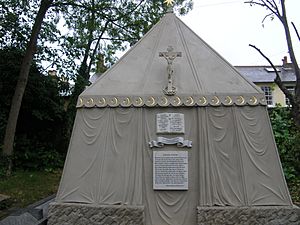
Who are Some Famous People from Mortlake?
Mortlake has been home to many interesting people throughout history.
People Living Today
- Katherine Jenkins, a famous classical singer, lives in Mortlake.
- Tom Hardy, a well-known actor and producer, grew up in Mortlake.
Historical Figures
- John Dee (1527–1608/09) is one of Mortlake's most famous past residents. He was a mathematician, astronomer, astrologer, and alchemist. He also advised Queen Elizabeth I. He lived in Mortlake for many years. His house is no longer there, but it later became the Mortlake Tapestry Works.
- Sir Christopher Packe (1593?–1682), who was a Lord Mayor of London, lived in Mortlake around 1655–1660.
- John Partridge (astrologer) (1644–c.1714) was born nearby in East Sheen and worked as a shoemaker. He died and is buried in Mortlake.
- Edward Colston, an English merchant and philanthropist, lived in Mortlake from about 1689 until he died in 1721.
- The cemetery of St Mary Magdalen Roman Catholic Church Mortlake holds the tomb of the famous Victorian explorer, Sir Richard Burton (1821–1890).
- Former British Prime Minister Henry Addington (1757–1844) is buried at St Mary the Virgin Mortlake. He was also in charge of Richmond Park for a time.
- Ada Lovelace (1815–1852), a brilliant English mathematician and writer, lived in Mortlake when she was 15 years old.
What is Mortlake's Economy Like?
Mortlake is mainly a place where people live and then travel to work (a commuter town). It has a history of small businesses and trades. The main shopping area is on Upper Richmond Road, which is also partly in East Sheen. East Sheen used to be a smaller area within Mortlake. Now, it's a busy place for dining and shopping for both districts.
The older, winding Mortlake High Street (also called Lower Mortlake Road) used to have more businesses. But with cars becoming popular, most buildings there are now homes or were used by the brewery.
The Famous Stag Brewery
The Mortlake Brewery has been around since the 1400s! In the 1840s, Charles James Philips and James Wigan took it over.
In 1889, a company called James Watney & Co. bought the brewery. Later, it became part of a bigger company called Watney Combe & Reid. When another Watney's brewery in London was closed in 1959, the Mortlake brewery was given the name "Stag Brewery" about 30 years later. However, many people still call it the Mortlake Brewery, especially because it's linked to the end of The Boat Race.
The brewery later became part of Scottish & Newcastle and then Heineken. Finally, it was owned by Anheuser-Busch Europe Ltd, where it made Budweiser beer. In 2009, Anheuser-Busch InBev announced they would close the Stag Brewery. It officially closed in December 2015.
In 2015, the brewery site was sold for a lot of money to a company from Singapore. There are now plans to build 850 apartments on the 22-acre site.
What Can You Do in Mortlake?
Mortlake offers great views of the River Thames. Its riverside path is right next to buildings like the old brewery. This is different from some other parts of London where roads run along the river.
There are two large pubs right on the riverside promenade:
- The White Hart
- The Ship
Places of worship in Mortlake include:
- St Mary Magdalen Roman Catholic Church Mortlake
- St Mary the Virgin Mortlake (an Anglican church)
How Do People Get Around Mortlake?
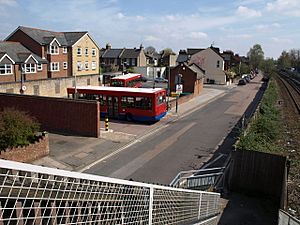
Nearby Areas
Mortlake is next to these other districts:
- Barnes
- Chiswick (specifically Grove Park)
- East Sheen
- Kew
Train Stations
The closest train stations are:
- Mortlake railway station
- North Sheen railway station
These are smaller stops on the Waterloo–Reading line. This line has different routes, but trains to Windsor or Reading do not stop at Mortlake or North Sheen. The railway line runs through the middle of Mortlake, often separating streets like Worple Way into north and south sides.
How Many People Live in Mortlake?
To make sure that all local voting areas (wards) have about the same number of voters, the Mortlake ward also includes parts of Barnes.
| Ward | Detached | Semi-detached | Terraced | Flats and apartments | Caravans/temporary/mobile homes/houseboats | Shared between households |
|---|---|---|---|---|---|---|
| Mortlake and Barnes Common | 167 | 547 | 1,765 | 2,453 | 1 | 8 |
| Ward | Population | Households | % Owned outright | % Owned with a loan | hectares |
|---|---|---|---|---|---|
| Mortlake and Barnes Common | 10,919 | 4,771 | 27 | 32 | 185 |
See also
 In Spanish: Mortlake para niños
In Spanish: Mortlake para niños


